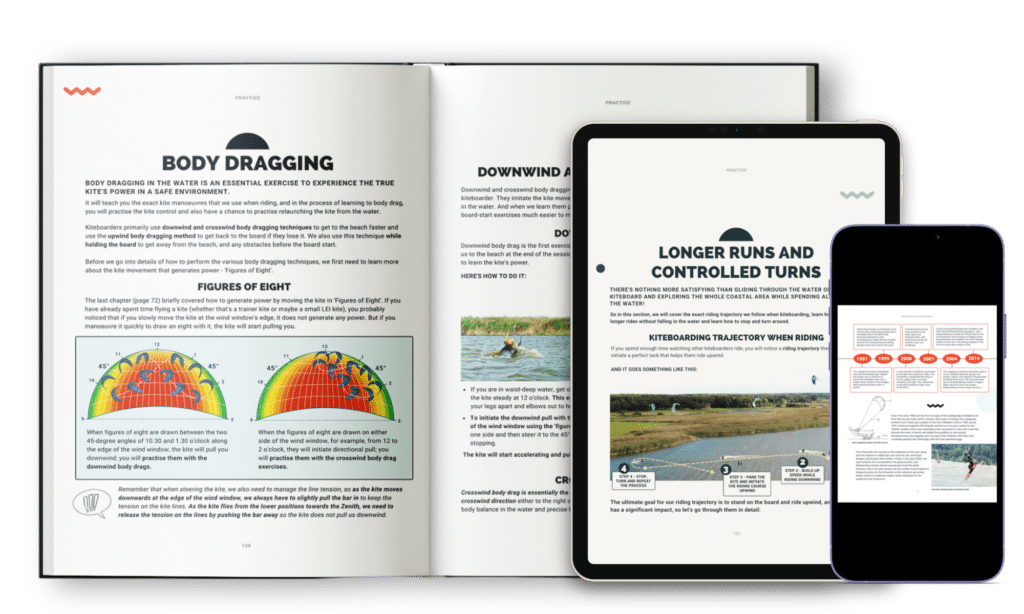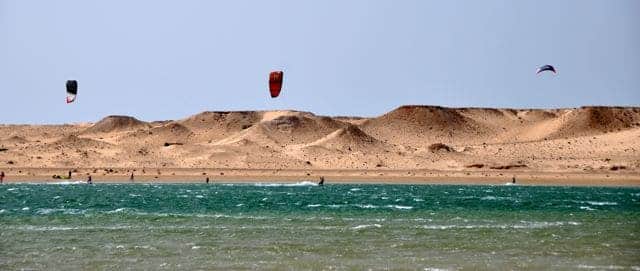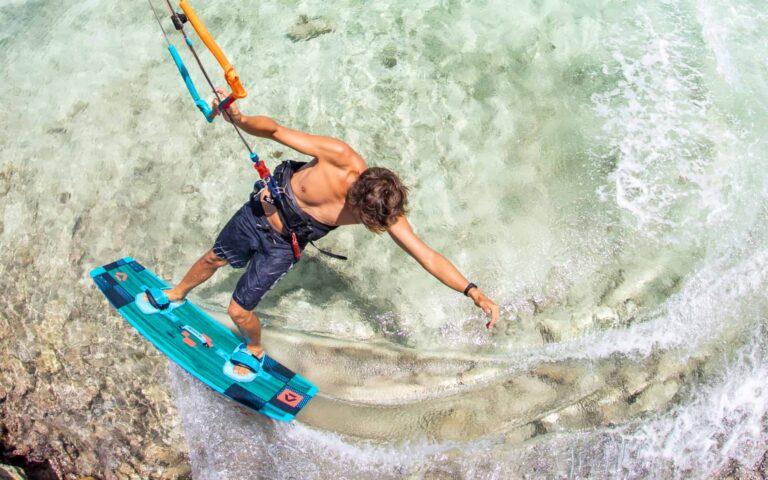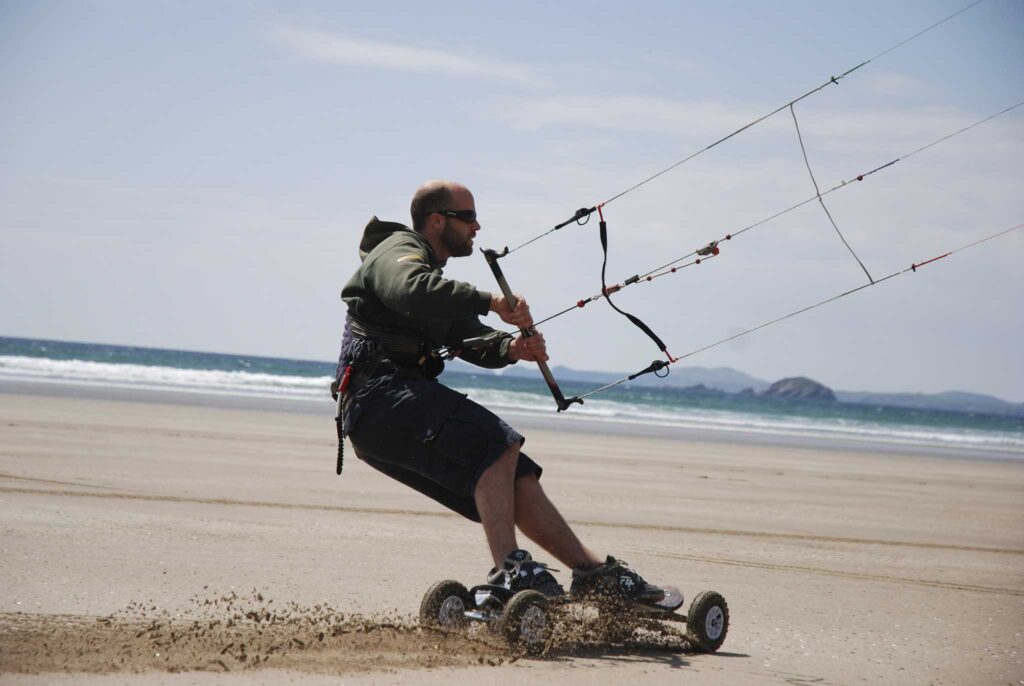Table of Content
Learning a new sport have to start somewhere, and learning kitesurfing or other kitesports disciplines like landboarding begins with learning to fly a trainer kite. Also, it’s a great outdoor activity that the whole family can enjoy!
We always recommend you to take lessons from an experienced kiteboarding instructor, but if you are only flying a small trainer kite and low winds and pleanty of space, the knowledge we highlighted bellow and across this website should be enough to get you going.
What is a trainer kite?
Trainer kites, as the name suggests, are the entry-level power kites used for training to get into the kitesports; these kites are usually very small from 60cm to around 3m depending on the wind speed it will be used in, and the learner’s weight and abilities. The most common trainer kites are small de-powerable foil kites with a 2 or 3 line control bar. This type of kites are the easiest to control and are best in recreating kite movements and behaviours as the bigger size kites used for kitesports.

How to choose a trainer kite?
#1 How will you use the trainer kite?
If you are landbound and don’t want much power, then the open cell foil kites will be best suited, but they cannot be used in the water. If you are not sure if you will use the kite only on land or maybe in or near the water, we would suggest in looking at a closed cell foil kites or small LEI kites as they can re-launch from the water.
#2 What type of set up do you want?
- Most kiters and schools choose a 2 or 3 line trainer kite as they are straightforward to set up and don’t require a harness. Kite is secured to the pilot with a velcro wrist leash.
- 4 line kites are designed for more advanced pilots. They are more complicated to rig up and often require a harness.
Control bar or Handles? Most of the trainer kites are sold with both options. If you are planning to get more into land kiting or buggying or maybe want to spice up your kite flying skills, we would suggest starting to learn with a control bar and then move on Handle control.
#3 What size kite?
Trainer kites come in a variety of sizes, from really small 0.5m to average size 3m – 4m, to larger foil kites. When choosing a kite, we need to consider the three “W’s”:
Winds – How strong are the winds in the area and on the day you choose to practise? The stronger the wind, the smaller the kite. All of the kites big or small have set wind parameters they can fly in, so check with the manufacturer’s guidelines.
Weight – How much do you weigh? A lighter person in strong winds should consider smaller kites. Bigger people may choose bigger kites.
Who – Will you be sharing your kite? Think about the smallest person that will be flying your kite. If you are purchasing a family kite, for safety reasons, you want to get a kite that is suitable for the kids or fly it in a small winds.
For example, an average-sized guy that weighs 80kg, flying in winds of 12-18 mph would do well with a 2-3m kite.
Essential knowledge and safety
Even if you fly a small trainer kite, you need to understand the basic safety procedures and considerations. Most importantly, you need to find a safe area to practice kite flying. The most popular and safest areas are large open fields, free from obstacles and trees or a large open beach.
When we fly a kite, we have our back to the wind and the kite flies in the wind window that is determined by the wind direction and the line length of your kite. We should always aim in keeping that wind window area and at least double that in the downwind direction free of other people, obstacles anything that can injure you or can cause damage to if the kite gets disconnected from you.
To choose your spot correctly, you need to understand the wind. It does not just determine the location where you can practice but also allows you to choose the best equipment for your training. More about the wind directions and the exact terminology of downwind, upwind and cross-wind and other terms that you will encounter while learning to fly a power kite, check this article.
Understand the concept of ‘Wind Window’
If you have been looking at learning to fly a kite or you took some lessons already, then you head the term ‘wind window’ mentioned a lot.
The wind window is essentially an area where the kite flies. It is determined by the length of your kite lines, and it moves as you move with the kite. If your kite lines are ~20m long, then this area will span 20m downwind, in both directions cross-wind and up towards the sky. This area always has to be free of any hazards and other people.

How to set up a trainer kite?
- Start in an open space away from hazards.
- With your back to the wind, open up your kite and place it on the ground leaving the bridles facing up and the vented leading edge furthest away from you.
- Check the bridles are not tangled.
- Weigh down the kite along the trailing edge using sand or a weighted bag.
- Unwrap your lines and walk upwind of your kite.
- Place the bar on the ground with the red side of the bar on the left and the safety line running cleanly through the bar.
- Walk up your lines and separate them. The red steering line will go to the left steering bridle. The right side steering line (often blue, green or black) will go to the right steering bridle.
- If your kite has 3 lines, the safety line will attach to a bridle long the trailing edge.
- Connect each line using a larks head knot. Pass the loop over it’s own line and pull through to make the larks head. Pass this over the pigtail knot on the bridle and pull tight.
- Your kite is now set up. Double check each connection and that your bar is the correct way up (red left) before attempting to fly the kite.
How to fly a trainer kite?
Before flying, become familiar with the kite controls. The kites direction is controlled by steering left and right on the bar like riding a bicycle. If you pull your left hand towards you and extend your right arm, the kite will fly left. Steering right will pull the right bridle and the kite will pivot right. Your wrist safety leash will disable the kite; to use it, just let go of the bar.
For your first attempts, practice in low wind speeds. Do not exceed the manufacturer recommended wind speeds for your kite.
- Start in an open space away from hazards. Attach your wrist safety leash before flying the kite.
- With your back to the wind, pick up the bar and step backwards. The kite will catch the wind and fly upwards. Keep your bar straight, no steering to left or right and the kite will fly overhead.
- Steer left and right starting with small movements and progressively increase as you gain confidence with control. Keeping the kite high will produce less power. Steering the kite low will increase power.
- Aim for symmetry in kite movement. Imagine the upper half of a clock face in front of you and steer the kite in a figure of 8 (infinity) movement between 10 O’clock and 2 O’clock. This will produce power downwind.
- To move right, move the kite between 12 O’clock and 2 O’clock, down and up repeatedly as if drawing a wave.
- To move left, move the kite between 12 O’clock and 10 O’clock, down and up repeatedly as if drawing a wave.
- Larger movements down and up will produce more power, smaller movements generate less power.
- Practice keeping the kite still at 10, 11, 12, 1 and 2 O’Clock. When you can keep the kite still with 1 hand, you can then pick up a kite landboard.
- Remember, if you loose control, let go of the bar to activate your safety system.
Once you master how to fly a trainer kite, you can then spice it up with learning to kite landboard or buggy. And if you like water sports, transitioning to kiteboarding would be much easier.














